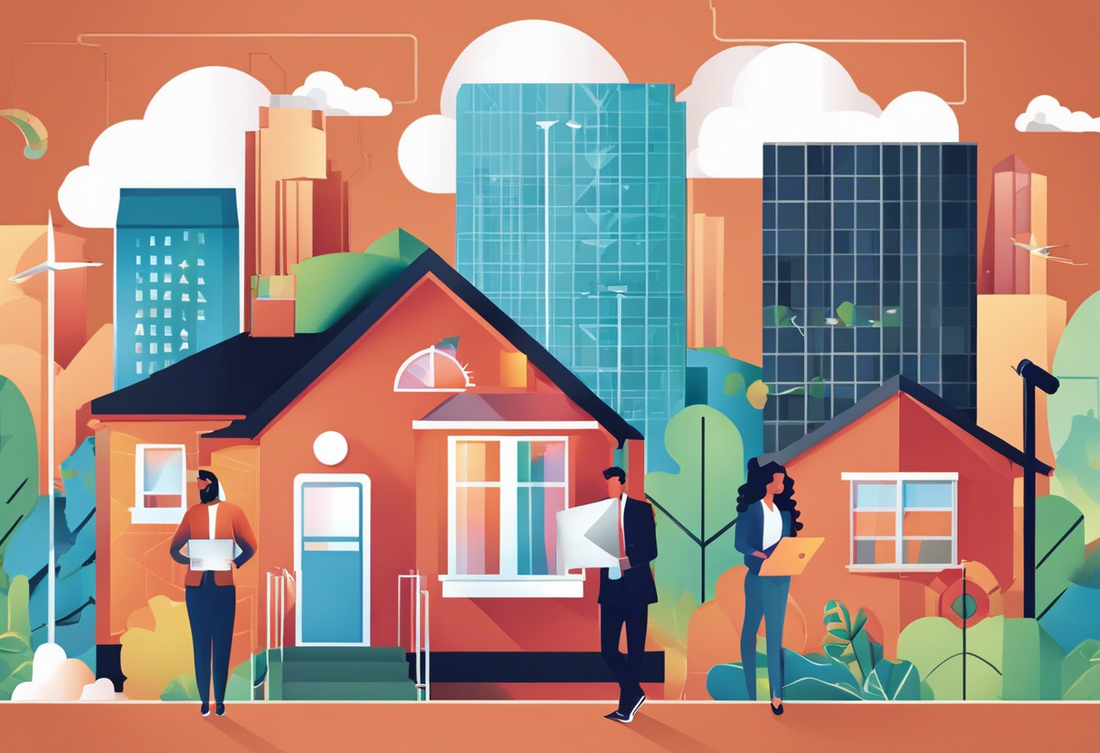Here's an overview:
- Introduction
- Trend 1: Shift towards Suburban Living
- Trend 2: Rise of Remote Work
- Trend 3: Impact of Technology on Real Estate Transactions
- Trend 4: Sustainable and Eco-Friendly Features
- Trend 5: Affordability Challenges in Major Cities
- Trend 6: Influence of Generational Preferences on Housing Market
- Trend 7: Changes in Mortgage Rates and Financial Policies
- Trend 8: Investment Opportunities in Real Estate
- Conclusion
Introduction
The residential real estate market in the United States is constantly evolving to reflect changing economic conditions, societal trends, and consumer preferences. Understanding key trends in this dynamic market is essential for real estate professionals, investors, and potential homebuyers. Here are five crucial trends shaping the United States residential real estate market:
-
Shift towards Suburban Living: Due to the COVID-19 pandemic, there has been a noticeable shift towards suburban living as people seek larger homes, outdoor space, and a lower density of population. This trend has led to increased demand for single-family homes in suburban areas.
-
Rise of Remote Work: The widespread adoption of remote work has empowered individuals to seek homes away from major urban centers. This has fueled demand for housing in smaller cities, towns, and rural areas, where residents can enjoy a lower cost of living and a higher quality of life.
-
Sustainable and Green Homes: Homebuyers are increasingly interested in properties that are eco-friendly and energy-efficient. Features such as solar panels, smart home technology, and sustainable building materials are becoming more prevalent in the residential real estate market.
-
Affordability Challenges: The rising cost of housing in many parts of the country has created affordability challenges for potential homebuyers. This trend has led to an increase in demand for affordable housing options and innovative financing solutions.
-
Digital Transformation: The real estate industry is undergoing a digital transformation, with online listings, virtual tours, and e-signing becoming standard practices. This trend has made the home buying process more accessible and efficient for consumers.
These five key trends highlight the ongoing evolution of the United States residential real estate market and underscore the importance of staying informed about market dynamics and emerging opportunities.
Trend 1: Shift towards Suburban Living
- Many individuals are choosing to move away from urban areas towards suburban neighborhoods in search of more space, affordability, and a quieter lifestyle.
- The COVID-19 pandemic has accelerated this trend as remote work has become more common, allowing people to live further from city centers.
- Suburban living offers larger homes, yards, and a sense of community that appeals to families and individuals looking for a change in lifestyle.
- Real estate developers are responding to this trend by building more housing options in suburban areas to meet the growing demand.
- Suburban areas with good school districts and access to amenities are particularly desirable for those making the shift from urban to suburban living.
- The shift towards suburban living is influencing the types of properties in demand, with single-family homes, townhouses, and larger apartments gaining popularity.
- As more people seek out suburban living, there may be an increase in suburban sprawl and the need for improved infrastructure to support the growing population.
- The trend towards suburban living is expected to continue in the coming years as more individuals prioritize space, comfort, and a sense of community in their living environments.
Trend 2: Rise of Remote Work
- Remote work has become increasingly prevalent in the United States residential real estate market.
- The shift towards remote work has allowed individuals to live in locations of their choice, beyond traditional urban centers.
- This trend has led to increased demand for properties in suburban and rural areas as individuals seek more space and a change in lifestyle.
- Homebuyers are now prioritizing features like home offices, high-speed internet, and outdoor spaces to accommodate remote work arrangements.
- Real estate agents are adapting their marketing strategies to highlight properties suitable for remote work, emphasizing factors like home office potential and proximity to coworking spaces.
- As companies continue to embrace remote work policies, the trend of telecommuting is expected to have a lasting impact on the residential real estate market in the United States.
Trend 3: Impact of Technology on Real Estate Transactions
- Technology has revolutionized the way real estate transactions are conducted in the United States.
- Real estate agents now leverage digital tools and platforms to market properties more effectively and reach a wider audience.
- Online listings have made it easier for buyers to search for homes based on specific criteria such as location, price, and amenities.
- Virtual tours and 3D imaging technology allow buyers to view properties from the comfort of their homes, saving time and effort.
- The use of electronic signatures streamlines the process of signing contracts and closing deals remotely.
- Data analytics and artificial intelligence help real estate professionals make informed decisions by analyzing market trends and predicting property values.
- Blockchain technology is increasingly being utilized to ensure the security and transparency of real estate transactions.
- Overall, technology has improved efficiency, transparency, and convenience in residential real estate transactions in the US.
Trend 4: Sustainable and Eco-Friendly Features
-
Emphasis on Sustainability: The United States residential real estate market is witnessing a growing trend towards sustainability and eco-friendly features. Homebuyers are increasingly prioritizing properties that are environmentally friendly and energy-efficient.
-
Energy-Efficient Appliances: Homes equipped with energy-efficient appliances such as refrigerators, washers, dryers, and HVAC systems are becoming more desirable. These features not only reduce energy consumption but also lower utility bills for homeowners.
-
Solar Panels and Green Building Materials: Properties incorporating solar panels for renewable energy generation and green building materials like bamboo flooring or recycled glass countertops are gaining popularity. Such features appeal to environmentally conscious buyers looking to reduce their carbon footprint.
-
Smart Home Technology: Integration of smart home technology allows residents to control energy usage, lighting, and temperature remotely. This not only enhances convenience but also contributes to energy efficiency in residential properties.
-
Sustainable Landscaping: Eco-friendly landscaping practices, such as xeriscaping or rainwater harvesting, are becoming common in residential properties. These practices help conserve water and reduce maintenance costs for homeowners.
-
Government Incentives: Federal and state governments are offering incentives and tax credits to encourage the adoption of sustainable features in homes. These incentives play a significant role in promoting eco-friendly practices in the real estate market.
-
Long-Term Investment: Properties with sustainable features tend to have higher resale value and attract a broader pool of buyers. Investing in sustainable and eco-friendly features not only benefits the environment but also provides long-term financial gains for homeowners.
Trend 5: Affordability Challenges in Major Cities
- The United States residential real estate market is facing affordability challenges in major cities, primarily due to the increasing demand for housing in urban areas.
- As job opportunities and amenities attract more people to city centers, the limited supply of housing has led to a surge in prices, making it difficult for many individuals and families to afford homes.
- Major cities such as New York City, San Francisco, and Los Angeles are among those experiencing significant affordability issues, with median home prices far exceeding the national average.
- In these cities, the gap between wages and housing costs has widened, creating barriers to homeownership for a large segment of the population.
- The affordability challenges in major cities have also resulted in a rise in rental prices, further impacting individuals and families looking for housing options.
- Policymakers and real estate professionals are exploring various solutions to address affordability issues, including the development of more affordable housing units, implementing rent control measures, and incentivizing mixed-income developments.
- Despite efforts to tackle affordability challenges, the disparity between income levels and housing costs in major cities remains a pressing issue that requires ongoing attention and innovative solutions.
Trend 6: Influence of Generational Preferences on Housing Market
- Different generations have distinct preferences when it comes to housing, influencing the residential real estate market significantly.
- Millennials, the largest group of homebuyers, prioritize affordable and eco-friendly features in homes.
- Generation X tends to focus on finding homes with ample space and modern amenities to accommodate their families.
- Baby boomers often look for single-story homes with convenience, accessibility, and features that support aging in place.
- These generational preferences impact the types of properties being developed, the features included in homes, and the locations that are in demand within the housing market.
- Developers and real estate professionals need to understand these preferences to tailor their offerings to attract buyers from different generations.
- As younger generations become a dominant force in the market, the demand for smart homes, sustainability, and connectivity is expected to rise.
- The evolving preferences of each generation shape the future landscape of the residential real estate market, guiding investment decisions and development strategies.
Overall, the influence of generational preferences on the housing market is a key trend to watch as it drives changes in the types of properties being built and the amenities offered to cater to various age groups.
Trend 7: Changes in Mortgage Rates and Financial Policies
- Mortgage rates play a significant role in the residential real estate market.
- Fluctuations in mortgage rates can affect the affordability of homes for potential buyers.
- Changes in financial policies, such as interest rate adjustments by the Federal Reserve, impact the overall cost of borrowing for real estate transactions.
- Shifts in mortgage rates and financial policies can influence the decision-making process of both buyers and sellers in the housing market.
- These changes can result in shifts in demand for housing and ultimately impact property prices and sales volume.
- Monitoring mortgage rate trends and financial policy updates is crucial for understanding the dynamics of the residential real estate market.
- Real estate professionals and consumers alike must stay informed about changes in mortgage rates and financial policies to make well-informed decisions regarding buying or selling properties.
Thus, staying abreast of these trends is essential to navigate the ever-evolving landscape of the residential real estate market.
Trend 8: Investment Opportunities in Real Estate
- Investors are increasingly looking at real estate as a lucrative investment option in the United States residential market due to its potential for long-term appreciation and recurring income.
- The rise of real estate investment trusts (REITs) allows investors to pool funds together to invest in income-producing properties without directly owning them.
- Fix-and-flip properties have gained popularity as investors purchase distressed properties, renovate them, and sell them for a profit.
- Short-term rentals through platforms like Airbnb have provided investors with additional income streams by capitalizing on the growing demand for non-traditional accommodations.
- Crowdfunding platforms have democratized real estate investment, allowing individuals to invest in properties with lower capital requirements.
- Real estate remains a tangible asset that can provide a hedge against inflation and economic uncertainties, making it an attractive option for investors seeking diversification.
Investment opportunities in real estate continue to evolve and offer various avenues for investors to participate in the market and generate returns.
Conclusion
- The United States residential real estate market is witnessing significant trends that are reshaping the industry.
- Urbanization is driving demand for housing in city centers, leading to higher prices and increased competition.
- Technology is playing a crucial role in simplifying the buying and selling processes, making transactions more efficient and transparent.
- The shift towards sustainability and eco-friendly practices is influencing both consumer preferences and industry regulations.
- Demographic changes, such as the rise of millennials as the largest home-buying group, are impacting the types of properties being sought after.
- Overall, these trends highlight the dynamic nature of the residential real estate market in the United States, and understanding them is essential for investors, buyers, and sellers alike.

